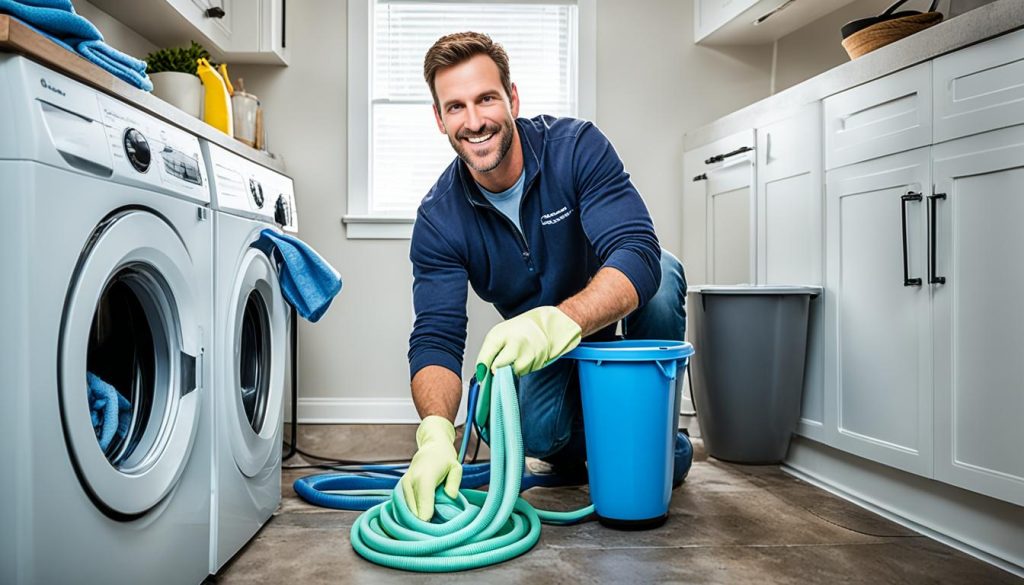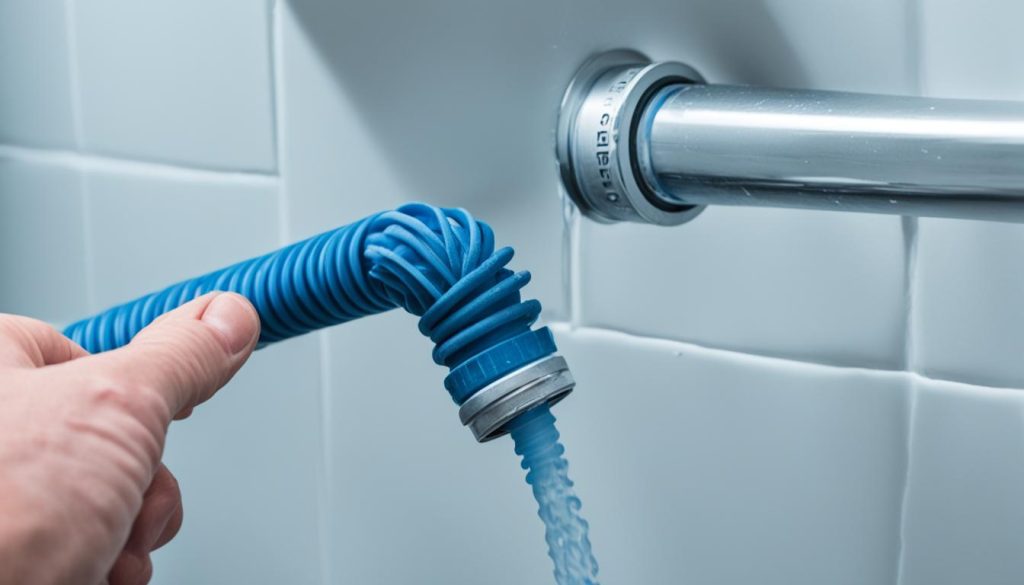Drain Water from Washing Machine – Easy Guide
Did you know that a washing machine that won’t drain is a common issue faced by many homeowners? In fact, according to recent studies, approximately 20% of washing machine malfunction complaints are related to water drainage problems. If you’re dealing with a machine that’s holding onto water, you’re not alone!
Key Takeaways:
- Draining water from a washing machine is a manageable task that can be done at home.
- Common reasons for a washing machine not draining include a closed or faulty lid, mechanical issues, clogged drain hose, or a blockage in the drain pump.
- Before attempting any other methods, check the lid and try the spin cycle to troubleshoot minor issues.
- If necessary, drain the drain hose and remove any obstructions.
- If all else fails, manual draining can be done by scooping out the water.
Reasons why a washing machine may not drain
When your washing machine fails to drain properly, it can be frustrating and inconvenient. Understanding the reasons behind this issue is crucial in order to address it effectively. Here are some common culprits that can prevent your washing machine from draining:
- A closed or faulty lid: If the lid of your washing machine is not completely closed or if the lid switch is faulty, it can disrupt the draining process.
- Mechanical blips: Sometimes, minor mechanical problems can hinder the drainage system. This can include issues with the motor or the pump.
- A clogged drain hose: Over time, the drain hose can accumulate debris, lint, or other blockages that impede the water flow.
- A blockage in the drain pump: The drain pump in your washing machine can become obstructed, preventing the water from draining properly.
Identifying the specific issue in your washing machine is essential for finding the most appropriate solution. By troubleshooting these common reasons for a washing machine not draining, you can take the necessary steps to resolve the problem and get your machine back in proper working order.
| Reason | Description |
|---|---|
| A closed or faulty lid | Ensure that the lid of your washing machine is properly closed and locked. Check if the lid switch is functioning correctly. |
| Mechanical blips | If you suspect a mechanical issue, consult a professional or refer to the manufacturer’s manual for troubleshooting guidance. |
| A clogged drain hose | Inspect the drain hose for any blockages or kinks. Clean or replace the hose if necessary. |
| A blockage in the drain pump | If other methods fail, it may be necessary to clean or replace the drain pump. Refer to the manufacturer’s instructions for guidance. |
Checking the lid and spin cycle
Before attempting any other methods, it’s essential to check if the lid of your washing machine is completely closed and locked. Many washers have a lid switch that must be engaged for the machine to run properly. If the lid is not the issue, you can manually turn the machine to the spin cycle to try and drain the water. This can often solve minor mechanical problems that may be preventing proper drainage.
Start by inspecting the lid of your washing machine. Ensure that it is securely closed and latched. If the lid switch is faulty or not engaging properly, the machine may not start or complete the cycle, resulting in water not draining from the tub.
If the lid is securely closed and the machine still doesn’t drain, try using the spin cycle to force the water out. Here’s how:
- Ensure the lid is closed.
- Select the spin cycle option on the washing machine’s control panel.
- Start the machine and let it run through the spin cycle.
The spinning action during the spin cycle creates centrifugal force, which helps to remove water from the clothes and drain it from the tub. This force can often dislodge any minor blockages or mechanical glitches that may be hindering proper drainage.
If the water starts to drain during the spin cycle, allow the machine to complete the cycle before checking if the water has fully drained from the tub.
| Pros | Cons |
|---|---|
| The spin cycle can effectively remove water from the tub. | May not resolve more complex drainage issues. |
| Simple and easy to perform. | Dependent on the functionality of the spin cycle and lid switch. |
| Can help identify if the spin cycle or lid switch is the cause of the drainage problem. | May not work if there are significant blockages or mechanical faults. |
Checking the lid and utilizing the spin cycle are simple troubleshooting techniques that can resolve minor issues and allow the water to drain from your washing machine. If these methods do not resolve the problem, continue with the next steps to further troubleshoot the drainage issue.
Draining the drain hose
If the spin cycle method doesn’t work, the next step is to drain the drain hose. For top-loading machines, you will need to disconnect the drain hose from the wall and drain the water into a bucket. While doing this, you should also check for any debris or clogs that may be obstructing the flow of water. For front-loading machines, you will need to access the drain line and remove any blockages before draining the water into a container.
Steps to drain the drain hose:
- Locate the drain hose at the back of the machine.
- Detach the hose from the wall or drainage pipe.
- Place a bucket or a large container beneath the hose.
- Allow the water to flow out of the hose into the container.
- While draining, check the hose for any kinks or twists that may restrict the water flow.
- Inspect the hose for any debris or clogs and remove them if necessary.
By thoroughly draining the drain hose and ensuring it is free from obstructions, you can help resolve the issue of a washing machine that won’t drain properly. If this method doesn’t solve the problem, then it may be necessary to explore other troubleshooting options or seek professional assistance.
Manual draining as a last resort
If all other methods fail to drain the water from your washing machine, manual draining may be your last resort. This involves scooping out the water from the drum using a container and towels to soak up any spillage. While this is not the most glamorous or convenient method, it can be effective in removing the remaining water until further troubleshooting can be done.
- Prepare a large container, such as a bucket or basin, and place it near the washing machine.
- With a towel or cloth, carefully wipe down the edges of the drum to prevent any water from spilling out.
- Using a container or a ladle, scoop out the water from the drum and transfer it into the prepared container.
- Continue scooping out the water until the drum is empty.
- Be sure to have additional towels or rags on hand to mop up any water that may have spilled during the process.
This method requires patience and care to avoid any accidents or further damage to your washing machine. If you are unsure about performing manual draining or if you encounter any difficulties, it’s advisable to seek professional assistance.
Tips for a safe and efficient water draining process
When it comes to draining water from your washing machine, safety should be your top priority. Follow these precautions to avoid accidents and damage:
- Turn off the power to the machine before starting the draining process. This will prevent any electrical mishaps.
- Wear safety gloves to protect your hands from any sharp edges or potential contaminants in the water.
- Be prepared for water leakage. Have towels and absorbent materials on hand to quickly clean up any spills or leaks.
- Use appropriate containers to collect the drained water. Ensure they are large enough to hold the volume of water without overflowing.
- Dispose of the drained water properly. Avoid pouring it down the drain if it contains detergent or chemicals. Instead, follow local regulations for safe disposal.
By following these safety precautions, you can ensure a smooth and efficient water draining process for your washing machine.
Here’s a helpful visualization to guide you through the steps:

| Step | Description |
|---|---|
| 1 | Turn off the power to the washing machine |
| 2 | Wear safety gloves to protect your hands |
| 3 | Place absorbent materials to handle water leakage |
| 4 | Position containers to collect drained water |
| 5 | Dispose of the drained water properly |
When to seek professional help
While the methods mentioned in this guide can help you drain the water from your washing machine in most cases, there may be instances where professional help is needed. If you have tried all the troubleshooting methods and the water still doesn’t drain or if you are unsure about performing the tasks yourself, it’s best to call a professional washing machine repair service.
Professional repair technicians have the expertise to diagnose and fix any complex issues with your washing machine’s drainage system. They can accurately identify the underlying problem and provide the necessary repairs or replacements. By opting for professional washing machine repair, you can save yourself the time and potential frustration of trying to fix the issue on your own.
Additionally, calling a professional for washing machine drainage issues ensures that the repairs are done correctly, reducing the risk of further damage or costly mistakes. They have the proper tools and knowledge to handle the problem efficiently, saving you from potential hazards and providing you with peace of mind.
- Investing Wisely: How Windows & Doors in Boost Property Value and Financial Health - April 24, 2025
- The Financial Impact of Personal Injuries: Why Legal Help Matters for Business Owners - April 16, 2025
- The Hidden Financial Costs of Domestic Assault: What Business Owners Need to Know - April 16, 2025













